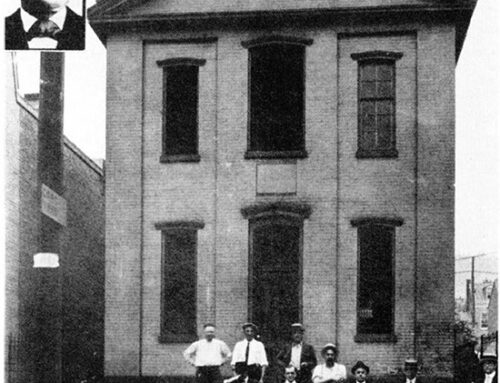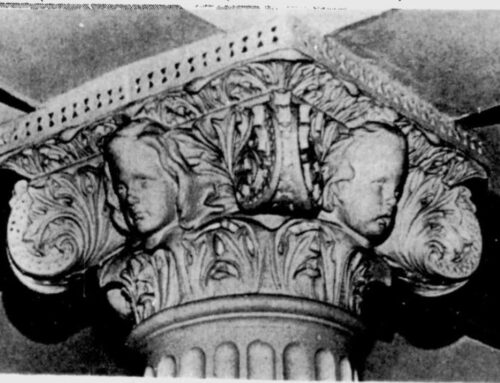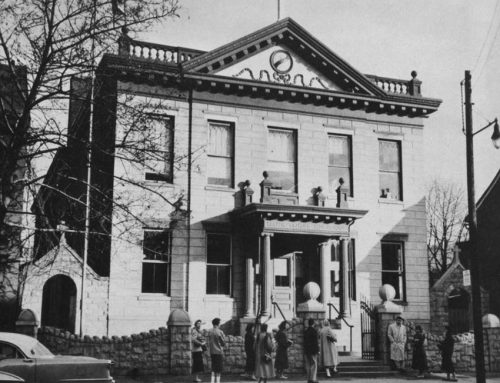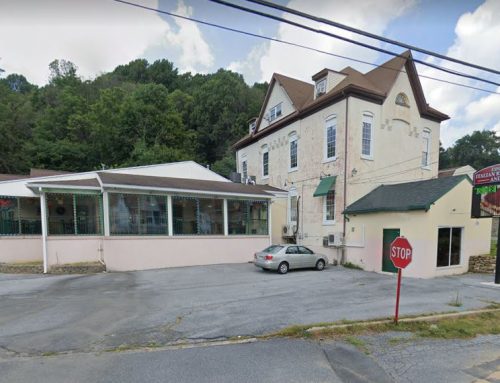Located off the northwest corner of Mull and Penn Avenue was an Octagon Schoolhouse – a true landmark in Sinking Spring.

This building was built on the property where the Tulpehocken Welsh Baptist Church had been located along with a cemetery. This church, in 1770, had 19 persons as members. By the late 1700s it only had Thomas Jones as its sole member, who was a son of the first pastor of the church and was buried in this cemetery. In 1801 the Philadelphia Association sold part of the property for $200. The original meeting house may have been used for school purposes later but, due to its fast approaching decay, the Octagon Schoolhouse was constructed nearby on another part of the Welsh property donated by Thomas’ son, Samuel.
Sources claim it to have been built in 1811 and another date of 1813 was given by Mathias Peifer, an aged man who lived in Sinking Spring and claimed to have helped haul the stone for constructing the building.
Eight-sided school-houses were once rather popular, early in the 19th century, because the design allowed for “good light and ventilation.”
The school was constructed of stone walls three feet thick, plastered, and whitewashed inside and out. Inside, the roof contained umbrella like rafters. The interior contained a continuous sloping shelf about three feet high which was attached to the wall all the way around the room, serving as a desk for the older children. In front of this were long, backless benches. A smaller shelf was located underneath the larger for books and belongings. A table was placed in the middle of the room with lower benches for the smaller children.
Below: Octagon Schoolhouse, circa 1948.


Midwinter enrollment reached about 70 to 80 pupils. There was only one teacher and the Master’s desk was located at the northern end, opposite to the entrance but inside the circle of desk shelving. His desk was also a place for confiscated tops, balls, pen knives, marbles, and the like.
The seats and desks were of pine and oak rudely fashioned by a local carpenter. A four-foot square blackboard was on the wall opposite the entrance. To use it, the child had to crawl on his knees on the sloping shelf.
A cast iron woodstove in the middle of the room heated the building and nearly roasted the little ones at the table. Wood was furnished free from the patrons and the older boys earned their tuition by cutting the wood. Tuition was 3 cents per day. The well-to-do sometimes volunteered to pay the way of their poorer neighbors.
Light came through six small windows of twelve panes each. Window panes were often broken and, in cool weather, the holes were often closed with someone’s hat.
The day began with the first class reading from the Testament. Writing came next and possibly the problem of either thawing out or watering of the ink. For each pupil the master set a copy at the top of the pupil’s copy book. Their book consisted of foolscap paper with a brown paper cover sewn on to it. When paper ran out, the child wrote in sand placed on the top of their slate.
Every good teacher knew how to make or mend a quill pen. First, you needed a sharp penknife. The new quill had to be scraped outside to remove the thin film covering it. One quick stroke cut off the underside. Next the slit was cut. Two strokes of the knife removed the comers, making the point. Delicately, the point was placed upon the thumbnail and the extreme end across the slit was removed. Not too blunt for too large a mark, not too fine to scratch. “Master, please mend my pen”, was among the first English taught.
Next, the second or third class read from the Testament, then their readers. Cobbs Juvenile Readers #1, 2 and 3 were among the first used here. Small children then had to repeat the alphabet or read from their primers or spellers.
In the afternoon, there was singing. The rest of the afternoon was a repetition of the morning. Once a week there was a spelling match using Comley’s New Spelling Book. The arithmetic used was either Pike’s or Rose’s. Pike’s contained over 300 rules and not a single explanation of one. This arithmetic was quite intricate.
Among the teachers who taught here were John Bush of Lancaster, Daniel Bittler of Robesonia, Thomas Huelett amd Henry Stettler. At that time, these teachers needed no diploma or state certificate to teach. The old masters weren’t hemmed in by rules or regulations of the school board. They taught as they saw fit. Severity of a teacher was considered a good attribute, often there were clashes between older pupils and the master. If the teacher wasn’t brave or athletic enough, he met with disaster. If the master was backward in using the rod, the parents inferred that the children were not learning. Obedience was the rule in every household. If a child was severely spanked, there was usually no parental protest. Bunches of apples or birch twigs were used. Whispering was considered a crime and most of the time a pupil was on watch for an offender waiting to hurl the leather strap at their head. The dunce stool was considered the most disgraceful form of punishment. Those placed on the stool were an object of ridicule for the whole school and a severe flogging was usually preferred to this.
About 1850 this building was abandoned when the common public school system was accepted. Later the building was used as a home with Mr. and Mrs. Johann Bogenshitz being among the first tenants. It was later occupied by David Reifsnyder and family. Lewis Kerschner occupied it starting in 1879, rent free, on condition of keeping the property in order. He added partitions and a kitchen annex to the building, He operated here a watch and clock repair shop. In the late 1890’s, the Philadelphia Association for the Baptists was still doing some overseeing of the cemetery property. In 1914 Mr. Kerschner purchased the property and some of the graves were dug up and the remains found were removed to the cemetery adjoining St. John’s Reformed Church including Francis Krick and other early members of his family. In March of 1927 the property was sold at public sale to an attorney for the purchase price of $2,837. More graves were removed to St. John’s Cemetery by Charles Wisser about 1930, which were uncovered when he constructed an auto grease pit near the schoolhouse. In later years it served as a lunch wagon, a home, pottery shop, summer cottage, beauty shop and once even as a gas station.
On December 10, 1959, despite interest in trying to save the structure which included a proposal to move it to the Sinking Spring school grounds on Vester Place, workmen began razing the building to be replaced by a gas station.

Below: Present day Northwest corner of Mull and Penn Avenue, Sinking Spring where Octagon Schoolhouse was located.







Leave A Comment